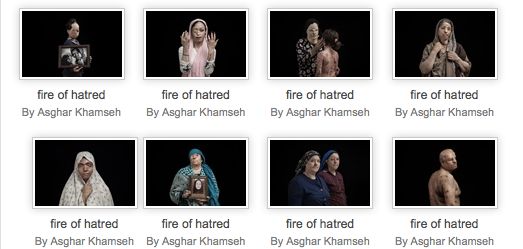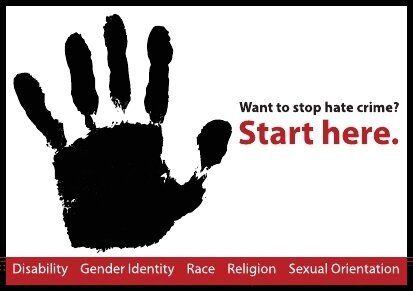The beauty of 18-year-old Shirin shines out from her one remaining eye as she holds up her scarred hands to the camera. You'll find her in the photo gallery of Persian journalist Asghar Khamseh who has just won the Sony Photographer of the Year award. His series, "Fire of Hatred", burns into your mind.

No one knows the total number of people who have been disfigured, disabled and destroyed in acid attacks worldwide. "We recognize acid attack as the most inhumane, barbaric form of assault that leaves indelible scars on the life of the person attacked, " says the Indian support organization "Stop Acid Attacks."
The Fire of Hatred
As you read the courageous testimonials of the women and men who are struggling to rebuild their lives after such savagery, another dark question forms - almost insidiously - in the mind. What kind of people are driven to these acts of extreme hatred and horrifying violence?
"The motivation to commit this type of violence is cultural destitution, intolerance," says the photojournalist Asghar Khamseh. His "Fire of Hatred" photos show nine women and one man. All are the dreadfully disfigured victims of revenge attacks, family conflicts, rejected marriage proposals, divorce requests, and a misunderstanding at work.
Reflecting on these vivid images, the mind reverses its focus from victim to perpetrator. Could these tortured faces and bodies be a metaphoric mirror of the inner world of those who inflicted such horrific violence? "Hatred paralyses life," said Martin Luther King Jr. Do the frozen stills of these disfigured survivors give us a glimpse of the paralysed psyches of their attackers, in the way that the eye of a corpse is said to capture the face of its murderer?
"Hatred is like a long, dark shadow," wrote the author Haruki Murakami in The Wind-Up Bird Chronicle, dealing with Japanese war crimes in China. "It is like a two-edged sword. The more violently you hack at the other person, the more violently you hack at yourself. It can often be fatal. Once it has taken root in your heart, hatred is the most difficult think in the world to shake off."
When we stare with utter shock and grim fascination at the melted and twisted skin of these men and women, are we also, in some way, being presented with snap-shots of the hate-crazed minds of Andreas Breivik, the Norwegian terrorist, or Dylann Roof who hoped to ignite a race war with his murderous assault on a prayer meeting in Charleston, South Carolina, or Mohammed Emwazi, known to the world as Jihadi John the knife-weilding executioner of Daesh, the so-called Islamic State?
These rivetting photos are icons of a global nightmare. "Acid attacks are a worldwide phenomenon that are not restricted to a particular race, religion or geographical location," says ASTI, the Acid Survivors' Trust International. "In many countries acid attacks constitute a hidden form of violence against women and children that often goes unreported, and the true number of horrific attacks taking place has only come to light after in-depth research by ASTI and its partners."
Hospital admissions for acid atttack victims in the UK have almost doubled in the last 10 years, The Guardian reported last year. A former gang member told the newspaper: "Young gang members are more ruthless than they used to be. It's now become part of the natural thought process to use acid; it's on the roster."

A culture of hatred
It would be tragic enough if the rising number of acid attacks were the only evidence of the "Fire of Hatred". But they're not. When someone tells you that this kind of vicious assault is "now part of the natural thought process", you know we're talking about a culture.
The terms "hate crime" and "hate speech" have entered the language. In Europe, where we once dreamed that the attitudes that erupted in the global conflagration of the 20th century would be banished once and for all, the Organization For Security and Cooperation in Europe now has a formal 57-nation "Hate Crime Reporting" program.
At the beginning of this year, it reported:
hate crimes against refugees and migrants occurred all along the so-called migrant route, in arrival, transit and destination countries alike. For example in Greece, Human Rights Watch reported that masked perpetrators, who were often armed, attacked boats carrying refugees in the Aegean Sea . . . Similar incidents have been documented in other transit countries. For instance, Amnesty International reported that refugees were robbed and injured by criminal groups in the former Yugoslav Republic of Macedonia. Destination countries have not been immune to episodes of violence against migrants and refugees. In Germany, data from the Federal Ministry of the Interior have recorded 850 attacks against refugee shelters in 2015. There were also attacks against asylum reception centres in Denmark, Finland, the Netherlands and Sweden.
"Hate violence is violence in which some aspect of the victim's social identity - their race, ethnicity, religion, sexual orientation, gender or gender identity, or a disability - plays some role in the reason for their victimisation," says Paul Iganski of Lancaster University and co-author of Hate Crime: A Global Perspective. "While the immediate impulses for the perpetrators vary, the violence is nested in a common denominator: a widespread denigration of social identities to one degree or another across nations and communities which permits discrimination, oppression and violence."
A sub-culture of extremism
When we hear the terms "hate crime" and "hate speech" we naturally tend to think of the issue in political and legal terms. But when gang members using acid as a weapon speak of deliberately disfiguring someone for life as being "on the roster", they are referencing the normalization, indeed the glorification of hatred, as part of popular culture and entertainment.
"Hatred", the video game released in June last year by Destructive Creations has been described in reivews as "the most violent game on earth." Here is how its producers pitch it to potential buyers:
Hatred fills your whole body. You're sick and tired of humanity's worthless existence. The only thing that matters is your gun and the pure Armageddon that you want to unleash.
You will go out for a hunt, and you will clear the New York outskirts of all humans with cold blood. You will shoot, you will hurt, you will kill, and you will die. There are no rules, there is no compassion, no mercy, no point in going back. You are the lord of life and death now - and you have full control over the lives of worthless human scum.
Only brutality and destruction can cleanse this land. Only a killing spree will make you die spectacularly and go to hell.
If you match the photos of Asghar Khamseh to these words, you get a chilling correspondence. The "Hatred" pitch echoes, not with the heroic victims painfully reclaiming their lives, but with the grotesque and tortured inner world of their attackers over whose spirits have fallen "the long, dark shadow of hatred".
The madness of this moment
"Our human abode is threatened with fire," said one of the world's most eminent Muslim spiritual leaders when he spoke at the General Assembly of the United Nations last year. Shaykh Abdallah bin Bayyah, President of the Forum for Promoting Peace in Muslim Societies, spoke of the need "to douse the flames of fanaticism that burn in people's hearts and minds". He called for "an alliance of cultural and educational strategies that can address the perils of war and violence and the madness of this moment in time, which an Iraqi poet of a century ago seemed to identify when he wrote:
Surely we are living in a time of such extremes:
One not driven mad by it, cannot be deemed sane.
Yet, as so often, it is in the "madness of this moment" that the resilience of the human spirit manifests. The records of the organizations working for the survivors of acid attacks, just as those working to end gang-violence in their neighbourhoods and war in the world, are filled with the stories of survivors and activists alike who have triumphed these horrors.
Campaigners in India have already scored a major success. They took their case to the nation's Supreme Court and won. The court has restricted wholesale commercial vending of acid throughout the country.
"We believe each one of us can potentially be an agent of change," says the website of India's "Stop Acid Attacks":
Our endeavor is to motivate and strengthen each survivor. To reassure them that confidence can be the spring in their step, and faith can fuel their dreams. Our deep and unstinted focus on the life of the survivors is what makes our campaign a life line for survivors. It is here that their painful past transforms into a fountain of strength for their fellows. Not only do they understand each other, they also become a beacon of hope for each other. They are comrades, medical advisors, listeners, and most importantly, friends. A voice for each other, an inspiration for each other.